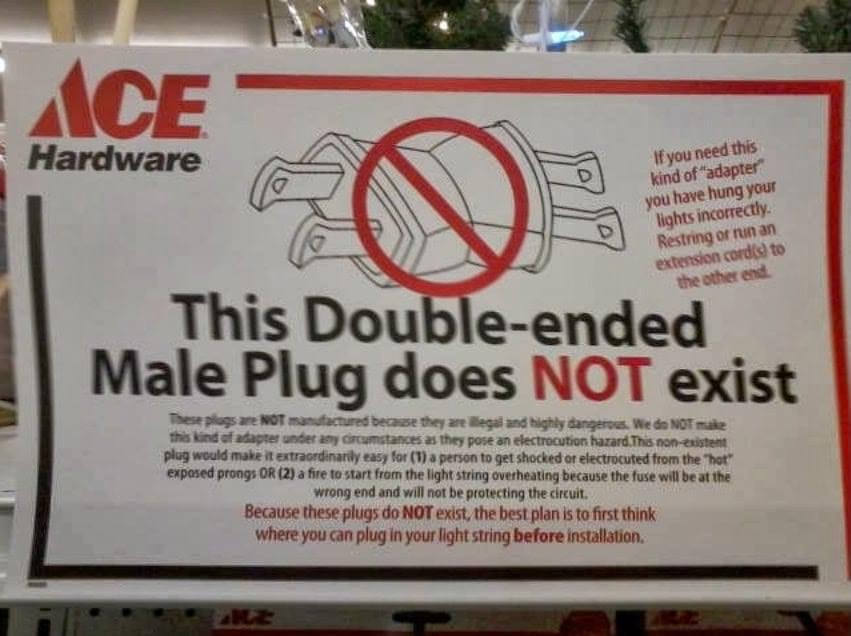The British one. It has a switch and a fuse, and later versions have age-verification so your kids can no longer plug in your adult toys.
Had me in the first half. Well played.
And your adult toys must be licensed, of course. To protect the kids.
Its important you don’t allow them access so you need to keep them on your person in a place thats very hard to access. So hard.
I’m actually kinda surprised that more don’t have switches, but I suppose if you have radial rather than ring circuits you don’t have to play ‘hunt the appliance that tripped all your switches’ quite so hard
My toys are wireless…
You’ll need a broadcasting licence for that, mate.
These are the best anyway
Nah, they’re too power limited. What you really want will require a 3 phase hookup to the bedroom.
In my opinion it’s Type-F
Because:
- It’s bi-directional
- It’s grounded and ungrounded plugs use the same socket
- It’s already widespread (50+ countries) source
- Your fingers can’t touch the live wire as you’re plugging in a wire
- It’s recessed
- Low footprint
- Accepts Type-C
Accepts Type-C
It took me a few seconds to realize you werent talking about shoving a USB Type C plug into there.
Bi-directional is a double-edged feature.
It means that there is no reliable way of identifying line and neutral wire, which requires more complex double switches downstream.
Also, F is unnecessarily clunky and big and hard to make a weather-proof version of because of the complex shape.
What’s the difference of C and F type?
C is mostly for low power devices
F is basically a heavy duty upgrade of C, it’s got grounding on the side and can handle 16A (ovens, heaters etc.)
Don’t you get numpties plugging F appliances into C sockets then complaining to customer service that the induction stovetop doesn’t boil water for tea fast enough?
no, because it’ll just trip fuse, and stoves are wired directly anyway
The type-C shown in the picture is also not the only form it has and maybe partly misleading, the plug usually is significantly smaller and flat, and power strips can feature multiple of those in less space.



As the least biased swiss person. Type J (or type N, Idk) is so much better. We put three plugs on the same surface as you have 1. I am always frustrated to see how impractical your plugs are when I go to the EU
I see a lot of your comments about F being objectively same or better compared to G. The only thing I’d throw into the mix is the socket switch feels so logical, I’m really surprised it’s not more standard.
High frequency use case: I don’t need my microwave on all the time showing me the time, so I switch it off at the socket unless I’m using it
Low frequency use case: before going on holiday I switch all the electrics off at the sockets
Socket switch isn’t really a feature of the socket itself. I’ve had schuko sockets with switches. It’s just not as common
Why not switch off the fuse in the holiday case? More time efficient.
It’s bi-directional
That’s bad.
Why? It doesn’t make any difference with AC
Some people say it does with certain devices but I’ve never had anything I’ve run into. The American outlets have been used as bi-directional in most instances. (With 2 prong). If they had a ground then you can only go in one way. But that said… Obviously a cord without a ground can still plug into an outlet that has the ground set up. If the device wants the current to go in a certain direction they use one with a slightly larger prong on one side, but if you pick up any phone charger in America, you can plug it into any outlet any direction.
deleted by creator
If the device wants the current to go in a certain direction
That’s not how AC works
they use one with a slightly larger prong on one side,
That’s not Ground, it’s Neutral. Neutral is sometimes bonded to Ground, but they are fundamentally different things
The actual electrical device can be designed such that it depends on exactly which direction is live and which is neutral.
Imagine a circuit loop that, as you follow along the circuit, has an AC power source, then a switch, and then the electrical appliance, leading back to the AC source it started from.
If you design the circuit so that you know for sure that the live wire goes to the switch first before the actual load, then your design ensures that if there is a fault or a short somewhere in the appliance, it won’t let the live power leak anywhere (because the whole device is only connected to the neutral line, not the hot live voltage that alternates between positive and negative voltage). It’s safer, and is less likely to damage the internals of a device. Especially if someone is going to reach inside and forgets to unplug it or cut power at the circuit breaker.
In practice tons of outlets are wired the wrong way around.
F actually has a convention for the socket, which is probably ignored even more often, but I would never trust live and neutral not to have been swapped somewhere regardless of outlet.Just forcing plug designers to consider live/neutral being randomized in a very obvious manner might be safer in the long run than working on a partially broken system where someone manufacturer might be fooled into trusting it.
Could you give an example of such a device? Seems like a bad design
A simple lamp can demonstrate.
You have both live and neutral lines in the cable, coming up to a switch, which can either open the circuit on the live line or the neutral line. Then, the lamp itself has a single light bulb as the load.
If you place the switch on the live line, then the energy of the live line stops at the switch, with only whatever lower voltage is in the neutral line to actually be connected to the light bulb and lamp assembly.
But if you place the switch on the neutral line, you’re leaving the entire lamp on the voltage of the live line, which gives the voltage more places to potentially short circuit. If you were to take a non-contact voltage detector, you’d be able to detect a live voltage in the line leading up to the bulb, even when it’s not turned on.
You generally do this with the in-wall wiring and switches, too, and make the wall switches break open the circuit on the live line, not the neutral line. It’s just a better practice overall.
And no, the neutral line is not totally grounded, so it can still pose a danger, too. But safety is exercised in layers, and putting the switch on the live line is the better practice.
That’s a lamp in theory, but do you know of any actual lamps being sold where this matters?
in the US it’s fairly common, so probably some American manufacturers would do it that way
If there’s electricity reaching the bulb it would be lit no? So if I place the contact upside down, I wouldn’t be able to turn off my light?
It’s not electricity, exactly, but it is a higher voltage that is different from the average of everything around it. Electricity needs a closed loop to flow, and breaking open the loop with a switch means that no electricity flows, but the voltage of the live line goes up and down, creating an electric potential with anything that might be at a different voltage, if a conductor touches both.
Every device produced in the past few decades doesn’t care which wire is live.

Clear, informative and solution oriented. I wish all signs were this good.
Damn homophobes…
Because:
- It’s bi-directional
This is very convenient, and not a problem in 99.9% of cases, but there are some devices where it’s important to not have the hot and neutral wire swapped
What sort of devices
Solar Microinverters
why should those plug into a normal outlet regularly? wouldn’t that be a measure polarity and just leave it alone device?
It’s obviously the one in the country I live in. All the others that I have had zero experience with are from Satan.
Type I.
ElectroBoom (Youtube) made some points about Australia’s Type I. Seems it was very hard for him to electrocute himself. Lots of breakers on the outlets. I mean he did electrocute himself, but he was always going to.
The breakers aren’t on the actual outlets. We just have everything on breakers in the power box. So I think the Australian system is good, but it’s not inherently because of the outlets. Other types have the same safety benefits.
Also to add: all lighting and power circuits are required to be on RCBO’s or breaker+RCD unless they are extremely old switchboards that havent had any modifications done since the law was introduced (as modifying the switchboard would trigger an rewuired upgrade in most cases).
Any device that is in a common area that can be touched by a non-licenced person (ie non-electrician) should also be on a RCBO, but this isnt as well enforced.So even if you do manage to youch live parts on the Aus socket/plugs, you will be protected by the RCD/RCBO instantly.
The downside to the Aus socket is that it can be a little tricky/annoying plugging something in when you are reaching behind an object (like a couch or cupboard) and cant see the socket to line it up.
I would argue that neither of the plugs shown in the picture nor those mentioned by others are the best.
Ignoring current adoption, I think that IEC 60906-1 is the best plug. It is very similar to the Swiss plug and was intended to, at least in the EU, replace other plugs. It has quite a few advantages over the other plugs. It is rated at 16 A, has a compact form factor, is polarised, and has almost all the common protections except fuses (which are pretty much useless anyway). Currently it only is used in South Africa without major changes to the plug.
Compared to the Schuko (Type F):
- Much smaller. You can fit three plugs in the same space as a single Schuko plug (similar to Swiss triple outlets).
- It takes less force to plug in. Above 2.5A, Schuko plugs require a lot of force to plug in and pull out. To some extent, this is actually good for safety, but I would argue that, in the case of Schuko plugs at least, it’s too much
- It is also easier to plug in without seeing the plug since it isn’t round. Everyone who has tried to plug in a Schuko plug without seeing the holes knows how difficult it is
- It’s polarised/directional. In some very specific cases, there is a security advantage to using a polarised plug, but I think it’s also a hassle to only be able to plug in a plug one direction. It also fits Europlugs (the thin, small plugs with only two pins that are very common in Europe, e.g. on phone chargers)
Compared to (Typ G)):
- Wayyy smaller
- Not a stepping hazard
- Rated for 16A (instead of 13 A)
- No Fuse (Again, pretty unecessary)
Regarding three-phase power, I would argue that Swiss type 15 (10A) and type 25 (16A) plugs are the best. These are really cool because while beeing the same size as Schuko (Typ F) plugs, they can transfer three-phase power (so 11 kW; 230 V / 16A on all three phases). They also fit standard Swiss single-phase and Euro plugs. This makes plugging in large appliances like electric stoves much easier than in other countries.
I would find it quite cool if most countries switched to one common plug, and I think IEC 60906-1 would be best for that. It would also be possible to build hybrid sockets for many common plugs during the transition phase.
After making this post, reading all the comments and doing even more research. I have to say I 100% agree with you.
I’m glad.
Maybe it’s unreasonable but I still hope that maybe countries will decide to switch to this connector.
The large amount of different, outdated standards definitly are a safety risk and hassle, even within the EU (e.g. a Schuko Typ F plug can be plugged in in Denmark but then it has no ground connection. Which is a common thing people there do).
So it would be pretty great to have this be the new common connector in all 220V-240V 50 hz countries.
IEC 60906-1 That is not a reversible plug which is annoying at times.
It takes less force to plug in. Above 2.5A, Schuko plugs require a lot of force to plug in and pull out. To some extent, this is actually good for safety, but I would argue that, in the case of Schuko plugs at least, it’s too much Hmm, I get what you mean and this can be an issue and it’s probably the reason why plugs without grounding exist since they are easier to pull out.
It is also easier to plug in without seeing the plug since it isn’t round. Everyone who has tried to plug in a Schuko plug without seeing the holes knows how difficult it is Never had this issue
I didn’t even know there are different three-phase power plugs, but then again you rarely need those compared to the normal plugs
Look at the lengths the EU is going through trying to make it seem as it didn’t reluctantly recognise the superiority of the Swiss plug and adopting it
I will have to agree that the swiss plugs already are very good. From what I see the only improvement of IEC 60906-1 would be that the plug generally is rated for 16A. Besides that there really isn’t any improvement. The 16A rating is pretty cool for devices like 3KW electric kettles.
Because of how similar the plugs are, switzerland could migrate to IEC 60906-1 pretty easy. Since the polarity of the socket is reversed and the ground pin has a slightly different offset, you could have a dual-socket that has both the neutral and live conductor rated for 16A, and a earth conductor for old swiss plugs at the bottom and the earth plug for new plugs at the top. Because of the slightly different offset of the earth conductor but identical spacing of the neutral and live conductors, both swiss plugs and new IEC-60906-1 plugs would only fit in their correct orientation.
Is not Type N (used in Brazil) an implementarion of IEC 60906-1 without any major change?
The brazilian plug is sadly a bit different. The biggest changes are that it has a different current rating. There is a version with 10A and 20A. It also allows for pins to completely be made out of metal which is a security hazard.
So it is quite similar but not identical.
This is the most definitive argument that type J is superior to all others:
Image showing an arrangement of 3 swiss plugs in the same footprint as one french one
J is superior. Not only is it the most space efficient, it’s safe as the recessed plug prevents incompletely inserted pins from being shorted out if a conductor were to fall atop them.
The UK plug is nice. Very robust, it connects to ground before it reaches the power line and has a switch but it’s clunky.
When you unplug them, they have a habit of lying prongs upward. Standing on one naked Lego feel like a shag carpet. and to be honest the fuse isn’t really necessary with modern wiring f type plugs don’t have fuses in them and I’ve never had a problem with wires melting or anything. and with older sockets, the little flap that blocks the earth hole tends to get stuck. Apart from that they are the best.
I only use those as a tourist, but the plugs tend to fall out of the outlet constantly, especially if the plug is not just on a wire but has some usb-c adapter or such integrated.
Well the answer is obviously the UK plug some of those others are just plain bad. The question is are they all made largely obsolete by USB C ? and is that the closest we are likely to get to a universal plug and socket?
The eu has actually been trying for about 30 years has been trying to get universal plug but it keeps getting stopped by massive tech companies because money go up
You going to put 240VAC through USB-C?
No. They are not.
Kitchen appliances like blenders and mixers are going to draw more power than USB-C is capable of delivering even at their lowest settings.
Wait, China uses the AU plug?
Swiss Type J, because you can have three of them, taking up no more space than one German or French plug.
I have a strong preference for the German and Swiss types, but I think we can all agree that Japan massively fucked up. They took the already shitty American plug and just forgot about the ground.
In fairness the Americans don’t use the ground.
Depends on the device
I’m always amazed at how many of my friends’ houses that were built in the 50s-80s have outlets with the ground hole, but no actual route to ground. One day that’s going to bite somebody.
Japan also has 2 incompatible power grids, with the north running on 50Hz and the south running on 60Hz
All outlets should just be replaced with IEC C13. Robust and compact.
Solid choice. Good current handling, already ubiquitous for many applications.
And full of garbage the moment its unplugged
Still trying to figure out why Germany is listed separately from the EU.
Yeah, I think they just wanted to illustrate the variety within Europe.
Type K. I mean how can you say no to that face?

why would you shove things into it’s mouth?
I think shoving things into its eyes is more concerning
Because it likes it.
There was two different ways you could have ordered this alphabetically, and you failed to do either.
Isn’t it beautiful
As a Brazilian, that makes me so sad. We used to have a type that could fit European and American plugs, but they just changed it. Never gonna let it go hahaha
As another Brazilian, good riddance to that crap. The current standard is so much better. Anything that is compatible with the American standard is automatically a mistake. Now if only we could standardise the whole country on 220V and drop the need for different 10A/20A sockets…
That makes me sad for you guys…
















